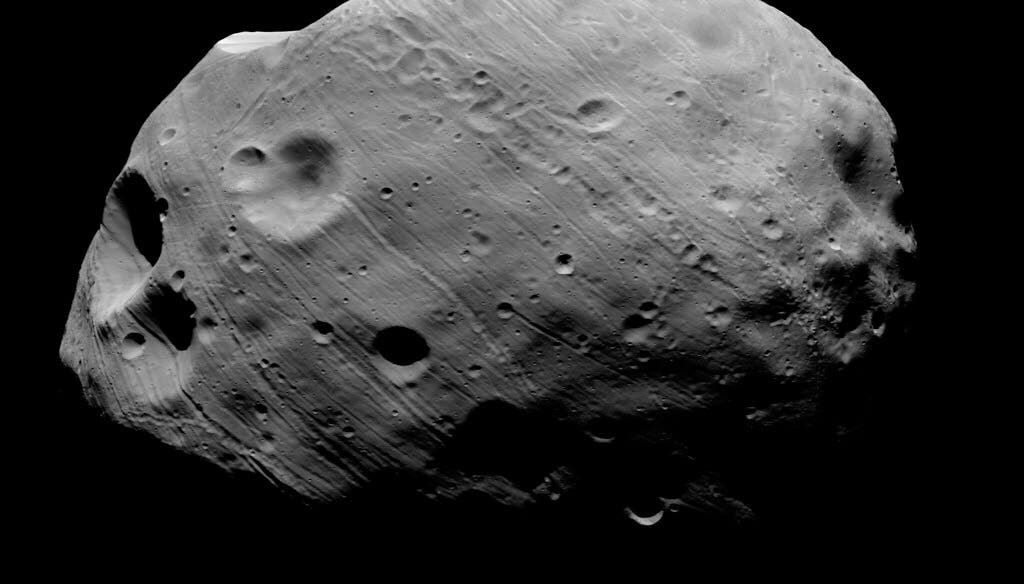Today, the red planet boasts two moons — Phobos and Deimos. Although we discovered them almost two centuries ago, their story was still a mystery. Both moons are very small and rough-shaped, which just isn’t very moon-y. A new paper suggests this is due to the fact that they aren’t really moons, but the remnants of a one.

Phobos, at only 22 kilometers in diameter, is really small — around 160 times smaller than our moon. Deimos is even tinier, with a diameter of only 12 kilometers. Furthermore, while the Moon is pretty much spherical, both of Mars’ are shaped very irregularly. You could describe them as potato-shaped quite accurately. In order to understand why, a team of researchers at the Institute of Geophysics at ETH Zurich used computer simulations to track the moons’ orbits back through time.
At one point, these simulations revealed, the two were likely a single body.
A cosmic breakup
“Our moon is essentially spherical, while the moons of Mars are very irregularly shaped—like potatoes,” says Amirhossein Bagheri, a doctoral student at the Institute of Geophysics at ETH Zurich.
“Phobos and Deimos look more like asteroids than natural moons.”
The first theory the team started working with is that the two are in fact asteroids that were captured by Mars’ gravity field sometime in the past. Still, this didn’t really pan out. Captured objects should, as far as we know, have eccentric orbits at random inclinations around their capturer — but neither Phobos nor Deimos does. They actually have almost circular orbits on the equatorial plane of Mars.
So they set out to simulate how their orbits changed over time, hopeful to get to the bottom of things. The simulation showed that if we go back in time far enough, Phobos and Deimos come to share the same orbit. This, the team says, likely means they’re both pieces of a larger, original body. In Greek mythology, Phobos (fear) and Deimos (terror) are the twin sons of Ares, the god of war. Given that the planet was named after the Roman equivalent of Ares — Mars, — this origin story seems quite fitting.
Still, I have massively simplified the work needed to reach these results. The team had to improve on what we know of the interactions between Mars, Phobos, and Deimos. Khan explains that these bodies all exert tidal forces on one another, leading to “a form of energy conversion known as dissipation, the scale of which depends on the bodies’ size, their interior composition and not least the distances between them”.
Luckily, NASA’s InSight mission is hard at work around Mars, and ETH Zurich supplied the electronics for the mission’s seismometer. With the data it supplied, the team refined our interior models of Mars, which in turn allowed them to improve on the equations describing this process of dissipation.
Data obtained from other instruments on other Martian craft also suggested that both moons were made of a very porous (and thus, lightweight) material. The team explains that this is true — their average densities, both at under 2 grams per cubic centimeter, are around half that of Earth (5,5 grams per cubic centimeter, on average).
“There are a lot of cavities inside Phobos, which might contain water ice,” says Amir Khan, a Senior Scientist at the Physics Institute of the University of Zurich and the Institute of Geophysics at ETH Zurich and co-author of the paper, “and that’s where the tides are causing a lot of energy to dissipate.”
Armed with this data and their findings on tidal interactions, they refined the models underpinning the simulations — then ran them a few hundred times for good measure. Depending on the exact parameters fed into the simulation, it shows that Phobos and Deimos were ‘born’ between 1 and 2.7 billion years ago. Until we know exactly what the moons’ physical properties are — especially porosity and water content — this timeframe will have to be our best estimate. A Japanese mission aimed for launch in 2025 will explore Phobos and return samples to Earth, so we might have a much better estimate in a few years.
As far as the original moon is concerned, the team says it orbited Mars at a greater distance than Phobos today. Deimos, owing to its smaller mass, has remained roughly at the distance this original moon was orbiting on. The more massive Phobos, however, has been drawn closer by tidal forces, and this process is still ongoing. The team’s simulations show that Deimos will keep drifting away from Mars (much like Earth’s Moon is doing), while Phobos will keep inching towards the surface. They estimate either an impact taking place in the next 40 million years or so, or for Phobos to break down under the strain of Mars’ gravity as it comes nearer.
The paper “Dynamical evidence for Phobos and Deimos as remnants of a disrupted common progenitor” has been published in the journal Nature.






